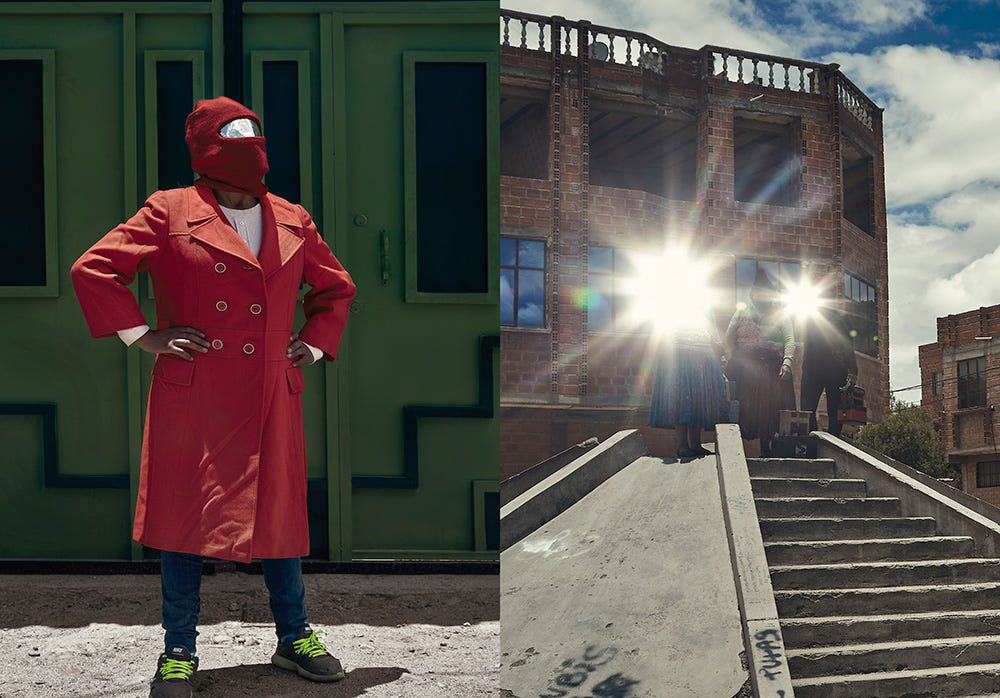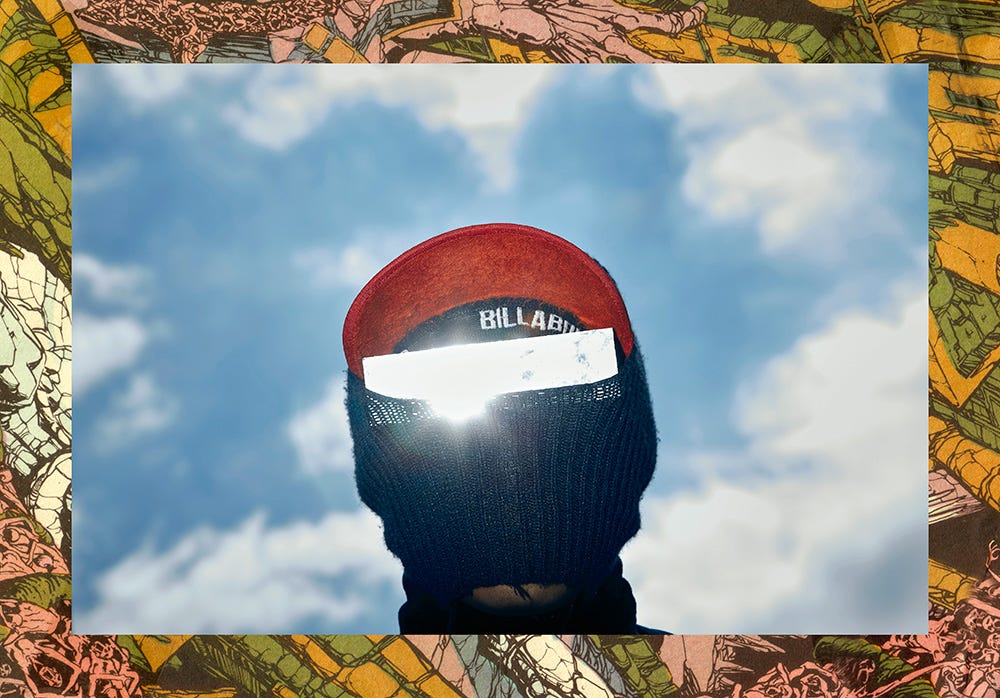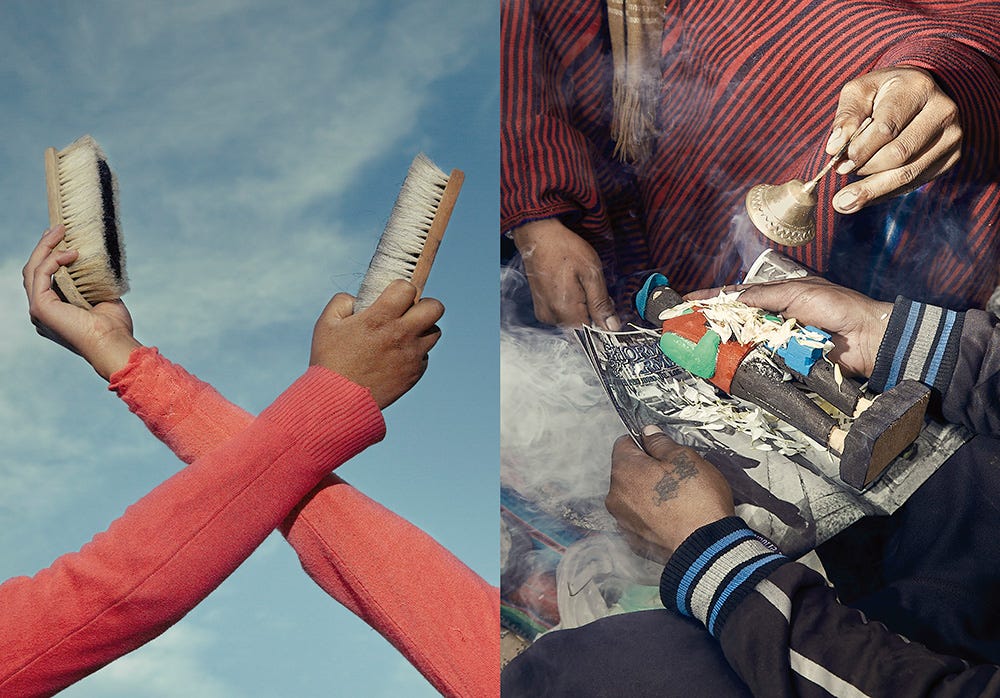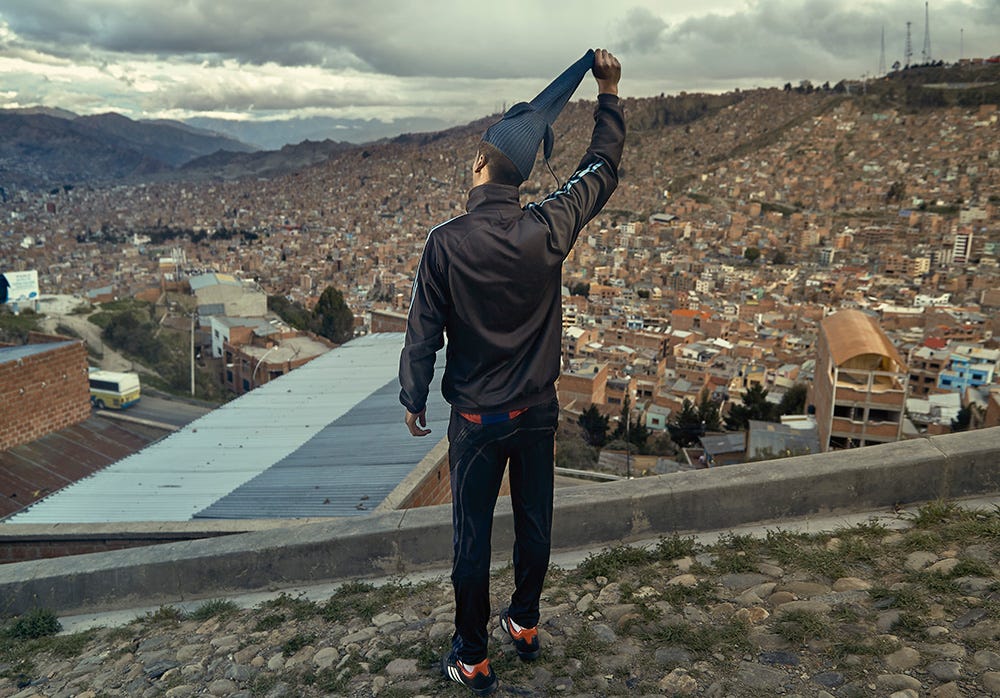Wearing clean shoes has lost primacy as a social norm in our day and age. Unless you work in an office or must attend a formal event, shoes go dirty without much thought or consequence, which isn’t good for the shoe-shining business.
Shine Heroes (Héroes del Brillo) is a collaborative project between the Uruguayan photographer Federico Estol and a group of sixty shoe shiners from El Hormigón Armado, an organization that protects the rights of these informal workers. Together they planned, photographed, edited, and sequenced the images over three years, resulting in a tabloid-sized zine. This humble yet inventive newsprint publication aims to spotlight the lustrabotas and the social conditions of the approximately three thousand shoe shiners in the Bolivian cities of La Paz and El Alto, where the profession has boomed the last decade.
The playful undertone of the zine renders the shoe shiners as an urban tribe with a defined set of characteristics we get to know as we go through its pages. The zine is heavily influenced by the aesthetic of comic books and cartoons, a concept that developed over many storyboarding sessions. Some of these drawings ended up collaged with the photographs in the publication. This mixture of fact and fantasy underlines the shoe shiners’ inclination to flee from the confines of their socioeconomic reality, with images at the edge of documentary photography (Estol prefers the term ‘ethnographic poetry’).
Two zine versions exist, one with ads sold by the shoe shiners and another without for the international public. While I got the ad-free version for review, I’m confident the local ads contribute to a sociological reading of the project. The sale and dissemination of the zine by the shoe shiners is part of a circular economy for the organization: Shine Heroes has been reprinted twice, totaling 18,000 copies, a number vastly superior to that of conventional photobooks. Estol has also given back to the shoe-shining community by sharing the monetary awards the project has received.
Estol staged many of the photographs in Shine Heroes, such as the portrait of a man using a small rectangular mirror as a visor that echoes the superhero Cyclops from the X-Men. Others he altered in postproduction to add ‘special effects,’ although a lack of resources forced him and his collaborators to get creative in achieving their vision.
They opted for a Brechtian approach that made the effects as evident as possible, thus establishing a whimsical register for the whole endeavor. In one of the project’s most striking photographs, a group of shoe shiners lights a bushfire in an empty lot using only the concerted power of their mirrors. In the background, a cluster of social housing towers covered with murals inspired by indigenous Andean culture shows the strong presence of syncretic imagery in everyday life.
Other photographs capture the spirit of manga battles, using literal smoke and mirrors to recreate the superpowers of Dragon Ball Z’s trademark characters. Interestingly, neither the staging nor the use of postproduction techniques negates the documentary weight of the photographs. They merely alter their symbolic value, prompting us to reflect on the commonalities across media that help construct meaningful stories. Several of these pictures also aim to replicate the sense of humor that often hooks young audiences to follow these sagas throughout the years.
A considerable problem of the global hegemony of American and Japanese superheroes is that they promulgate their values, settings, and character designs as universal. One of the virtues of Shine Heroes is that it riffs on some of these conventions to reflect on the shoe shiners’ cultural and geographical particularities, such as their outfits, tools, and hangout spots. As such, it becomes clear that even if the visual outcomes between conventional comic books and this one may be similar, the reasons behind the protagonist’s actions are different. The shoe shiners obscure their faces because they will be discriminated against if recognized, so they want to avoid shaming their families and communities by keeping their trade a secret. The mask becomes their new identity, making them look – depending on your take – like hikers, burglars, or hip-hop artists. Paradoxically, the accessory that provides anonymity also makes them stand out in the crowd.
Some viewers might get frustrated to find they are denied access to the shiners’ physiognomy and expression. In return, the book offers plenty of hand gestures as a stand-in for their character, considering that the shiners’ hands are the primary way they can give away their occupation if they don’t wash them properly.
Estol also showcases the objects essential to their subsistence, like in the stunning close-up of a toolbox wrapped entirely in golden paper to increase its shine and visual presence. The sides are also decorated with stickers from The Simpsons, creating a cacophony of yellows that, at least in my case, incited an empathetic laugh in which I recognized their creativity and high spirit. The act of running is also depicted several times, suggesting that their movable set-up facilitates their constant search for new patrons.
Shine Heroes has been exhibited in multiple photography festivals (Blue Sky, Format, Tucumán, etc.). Perhaps it has fascinated audiences in such diverse geographical regions because it provides a fresh and non-complacent view of people who tend to be depicted as victims. The sustained attention the project has received is significant given how many projects fight for visibility nowadays, many of which are inevitably passed over by a cultural ecosystem obsessed with newness.
The enduring power of Estol’s series is encouraging as it shows that a sensible project can have an extended public life while positively contributing to the community it depicts. The set of social relations – artistic workshops, talks, etc. – that framed the collaboration between Estol and the shoe shiners gave the zine its unique tone.
We don’t pity them but appreciate their fight for agency in a classist society, and we do this without ever seeing their faces. Estol’s lighthearted touch invites us to shed the usual preconceptions about the shoe-shining trade, portraying the desires of these men and women to better their living conditions as nothing short of heroic.
Arturo Soto is a Mexican photographer, writer, and educator. He has published the photobooks In the Heat (2018) and A Certain Logic of Expectations (2021). Arturo holds a Ph.D. in Fine Art from the University of Oxford, an MFA in Photography from the School of Visual Arts in New York, and an MA in Art History from University College London. Arturo lives in Wales, where he is a Lecturer in Photography at Aberystwyth University.
Arturo writes a series of reviews on Latin American photographers for Dispatches: The VII Insider Blog. Check out his other articles:
The Possibilities of the Actual: Adriana Lestido’s "Metropolis"
Pablo Hare: Sites of Exploitation in Peru
Feeling Out the Past: Graciela Iturbide’s “Heliotropo 37”
The Persuasions of Disobedience: Ana María Lagos
Messages of Angst and Hope: Notas De Voz Desde Tijuana
The Politics of Window Shopping: Pablo López Luz's Baja Moda
Life in a Lawless Town: Juan Orrantia’s A Machete Pelao
The Disenchanting Hunt for the Truth: Christo Geoghegan’s “Witch Hunt”











